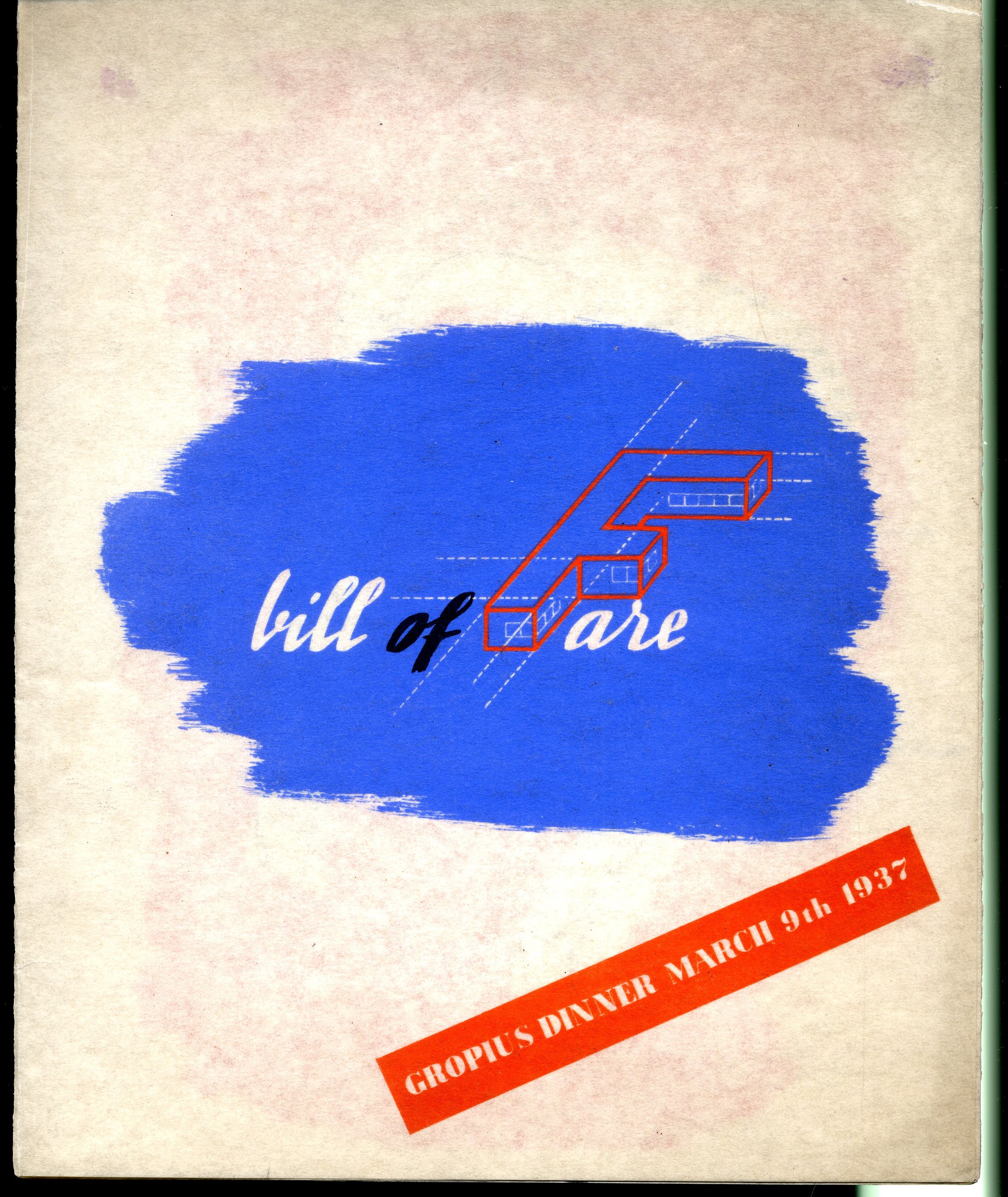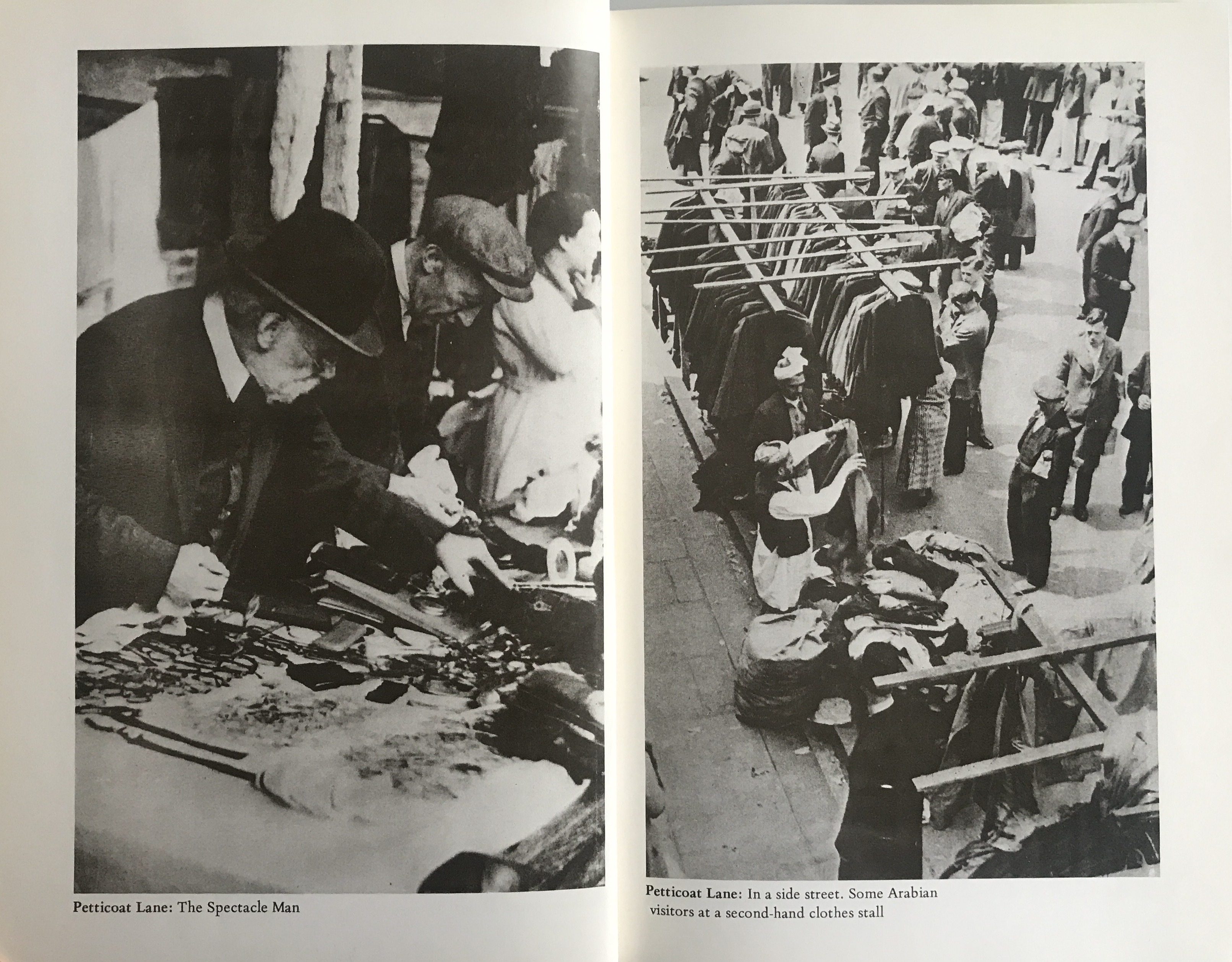Archive
László Moholy-Nagy
- László
- Moholy-Nagy
- 20-07-1895
- Bácsborsód (HU)
- 24-11-1946
- Chicago (US)
- PhotographerGraphic DesignerPainterSculptor
László Moholy-Nagy emigrated to London in 1935, where he worked in close contact with the local avantgarde and was commissioned for window display decoration, photo books, advertising and film work.
Word Count: 30

László Moholy-Nagy, Cover of sales leaflet for Marcel Breuer’s Isokon Long Chair, 1937 (Pritchard Papers, University of East Anglia, © László Moholy-Nagy). 
László Moholy-Nagy, Bill of Fare, farewell dinner menu for Walter Gropius, London, March 1937, front page (Pritchard Papers, University of East Anglia, © László Moholy-Nagy). 
Mary Benedetta. The Street Markets of London. Photographs by László Moholy-Nagy. (reissued 1972). Benjamin Blom, 1972, “Petticoat Lane: The Spectacle Man” and “Petticoat Lane: In a side street. Some Arabian visitors at a second-hand clothes stall” (Photo: Private Archive, © The Moholy-Nagy Foundation). 
Barbara Hepworth, Ben Nicholson, their triplets and Hattula Moholy-Nagy at 7 Farm Walk, the London home of László and Sibyl Moholy-Nagy, June 1936 (provided by The Moholy-Nagy Foundation). Benedetta, Mary. The Street Markets of London. Photographs by László Moholy-Nagy. John Miles, 1936.
Benedetta, Mary. The Street Markets of London (reissued 1972). Photographs by László Moholy-Nagy. Benjamin Blom, 1972.
Betjeman, John. An Oxford University Chest. Photographs by László Moholy-Nagy. John Miles, 1938.
Carullo, Valeria. Moholy-Nagy in Britain 1935–1937. Lund Humphries, 2019.
Daybelge, Leyla. “The Lawn Road Flats.” Insiders Outsiders. Refugees from Nazi Europe and their Contribution to British Visual Culture, edited by Monica Bohm-Duchen, Lund Humphries, 2019, pp. 165–171.
Daybelge, Leyla, and Magnus Englund. Isokon and the Bauhaus in Britain. Pavilion Books, 2019.
Fergusson, Bernard. Eton Portrait. Photographs by László Moholy-Nagy. John Miles, 1937.
Grieve, Alastair. Isokon. For ease, for ever. Isokon Plus, 2004.
Jackson, A.S. Imperial airways and the first British airlines 1919–1940. Terence Dalton, 1995.
MacLean, Caroline. Circles & Squares. The Lives & Art of the Hampstead Modernists. Bloomsbury, 2021.
Moholy-Nagy, László. “Die neue Typographie.” Staatliches Bauhaus Weimar 1919–1923, Bauhausverlag, 1923, p. 141.
Moholy-Nagy, László. Malerei Photographie Film. Albert Langen Verlag, 1925.
Moholy-Nagy, László. Postcard to Barbara Hepworth and Ben Nicholson. Ben Nicholson Papers (Tate Library and Archive, London, stamped 20 April 1934), TGA 8717/1/2/2973.
Moholy-Nagy, László. Letter to Ben Nicholson. Ben Nicholson Papers (Tate Library and Archive, London, 29 November 1937), TGA 8717/1/2/2978.
Moholy-Nagy, László. The New Vision. Fundamentals of Design, Painting, Sculpture, Architecture (New Bauhaus Books, 1). Translated by Daphne M. Hoffmann, Faber & Faber, 1939.
Moholy-Nagy, László. Letter to Ben Nicholson. Ben Nicholson Papers (Tate Library and Archive, London, 29 March 1946).
Passuth, Krisztina. Moholy-Nagy. Thames & Hudson, 1985.
Powers, Alan. Bauhaus goes West. Modern Art and Design in Britain and America. Thames & Hudson, 2019.
Read, Herbert. “A New Humanism.” Architectural Review, October 1935, p. 151.
Read, Herbert. “A Nest of Gentle Artists.” (1962) Art in Britain 1930–40 centred around Axis, Circle, Unit One, exh. cat. Marlborough Fine Art, London, 1965, pp. 7–8.
Schouela, Jessica. “Biology, technology and vision in Moholy-Nagy’s ‘Lobsters’, 1936.” Studies in Documentary Film, vol. 13, no. 2, 2019, pp. 156–168. Taylor & Francis Online, doi: https://doi.org/10.1080/17503280.2019.1595917. Accessed 9 April 2021.
Senter, Terence. “Moholy-Nagy’s English Photography.” The Burlington Magazine, vol. 123, no. 944, November 1981, pp. 659–671. JSTOR, www.jstor.org/stable/880538. Accessed 9 March 2021.
Senter, Terence. “László Moholy-Nagy: The Transitional Years.” Albers and Moholy-Nagy: From the Bauhaus to the New World, edited by Achim Borchardt-Hume, exh. cat. Tate Modern, London, 2006, pp. 85–91.
Tsai, Joyce. “Technikersatz: Zu den späten Bildern von László Moholy-Nagy.” László Moholy-Nagy. Retrospektive, exh. cat. Schirn Kunsthalle, Frankfurt am Main, 2009, pp. 136–138.
Vinzent, Jutta. “The Making of Modern Art through Commercial Art
Galleries in 1930s London: The London Gallery (1936 to 1950).” Visual Culture in Britain, vol. 21, no. 2, 2020. Taylor & Francis Online, doi: https://doi.org/10.1080/14714787.2020.1738265. Accessed 9 March 2021.Word Count: 417
The Moholy-Nagy Foundation, Ann Arbor.
Tate Library and Archive, London, Ben Nicholson Papers.
Word Count: 13
My deepest thanks go to Bridget Gillies (University of East Anglia Archive) for supporting me with images from the Pritchard Papers and to Hattula Moholy-Nagy and Natalia Hug (The Moholy-Nagy Foundation), for giving me permission to reproduce works by László Moholy-Nagy.
Word Count: 42
London, GB (1935–1937).
7 Farm Walk, Hampstead Garden Suburb, London NW11 (residence, 1935–1937).
- London
- Burcu Dogramaci. "László Moholy-Nagy." METROMOD Archive, 2021, https://archive.metromod.net/viewer.p/69/1470/object/5138-7556033, last modified: 29-09-2021.
-
Otti BergerTextile DesignerWeaverLondon
The textile designer and weaver Otti Berger lived in exile in London in 1937/38, where she sought to open up a new field of activity.
Word Count: 24
Julian HuxleyZoologistPhilosopherWriterLondonJulian Huxley was the director of London Zoo from 1935 to 1942 and worked closely with emigrant photographers, artists and architects, including Berthold Lubetkin, Erna Pinner and Wolf Suschitzky.
Word Count: 27
Margaret LeischnerTextile DesignerLondonThe designer Margaret Leischner lived in England from 1938, worked for textile and furniture companies, taught at the Royal College of Art and was honoured as Royal Designer for Industry.
Word Count: 29
Herbert ReadArt HistorianArt CriticPoetLondonThe British art historian Herbert Read established himself as a central figure in the London artistic scene in the 1930s and was one of the outstanding supporters of exiled artists.
Word Count: 30
A Hundred Years of Photography 1839–1939BookLondonSix years after her arrival in London, the photographer Lucia Moholy published her book A Hundred Years of Photography 1839–1939, on the occasion of the centenary of photography.
Word Count: 27
The Street Markets of LondonPhotobookLondonIn 1936, émigré photographer László Moholy-Nagy realised The Street Markets of London together with the journalist Mary Benedetta, setting the book within the overarching theme of urban photography.
Word Count: 28
Farewell Dinner for Walter GropiusDinnerLondonFriends and colleagues came together on 9 March 1937 to send off the architect Walter Gropius and his wife Ise Gropius, who had decided to leave for the United States.
Word Count: 28
Modern Art GalleryArt GalleryLondonThe Modern Art Gallery, founded by the émigré painter, sculptor and writer Jack Bilbo, was a forum for the presentation of modern art, specialising in the work of emigrant artists.
Word Count: 30
Faber & FaberPublishing HouseLondonFaber & Faber shows the importance of publishing houses as supporters of contemporary art movements and of the contribution of emigrants, helping to popularise their art and artistic theories.
Word Count: 29
Isokon CompanyArchitecture and Furniture CompanyLondonThe furniture design and architecture company Isokon was an important commissioner for emigrants such as Marcel Breuer, Walter Gropius, László Moholy-Nagy, Ernst Riess and Edith Tudor-Hart.
Word Count: 27
Kurt SchwittersArtistPoetLondonThe artist and poet Kurt Schwitters lived in London between 1941 and 1945, where he stood in contact to émigré and local artists, before moving to the Lake District.
Word Count: 27
Reimann School, LondonArt SchoolLondonThe Reimann School in London opened in 1937 and was a branch of the Berlin Schule Reimann, training students in commercial art and industrial design.
Word Count: 24